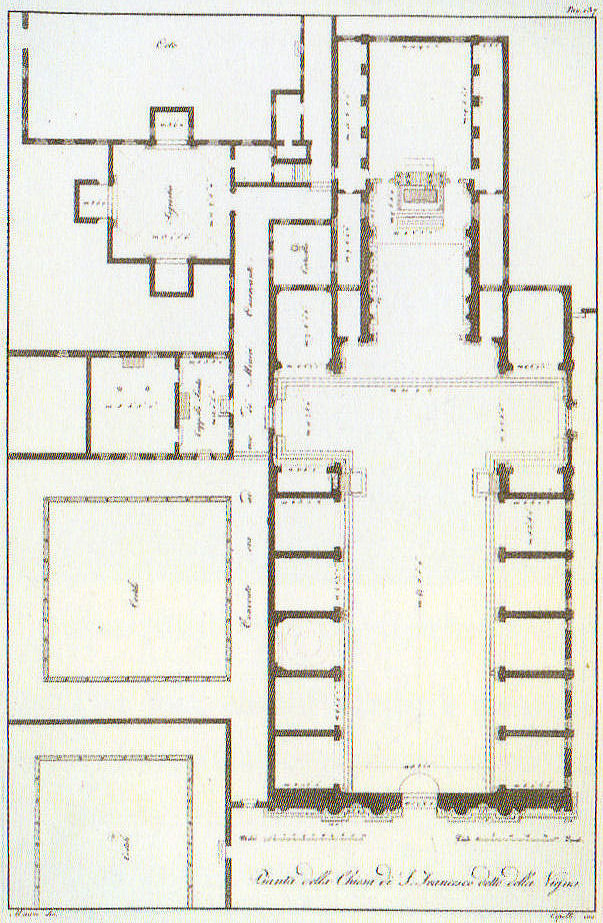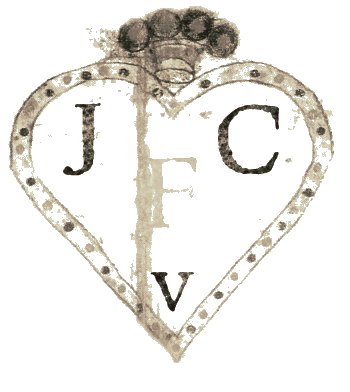
|
San Francesco della
Vigna |
||
|
History This church was built where, tradition says, Saint Mark was driven ashore by a storm on his way back from Aquileia. Here he was told by an angel that the Lagoon was to be his resting place and that 'the city that shall rise on these lagoons will call you its protector'. The original medieval church was built by Franciscans in 1253 on the site of a chapel in a vineyard (vigna). This church can be seen now only on Barbari's map of the city. Some sources claim that this original small chapel survived until 1810. Beginning with his laying of the foundation stone on August 15th 1534, Doge Andrea Gritti sponsored a reconstruction (to designs by the Florentine Jacopo Sansovino) with the intention of revitalising the area. Work was substantially completed by the end of 1554, and the choir in use, although consecration wasn't until 1582. Sansovino created arguably the first Venetian Renaissance interior, but failed to complete the façade. His original design is now only preserved on a medal (see above) with Gritti's profile on the obverse, which shows the dome originally planned but never built. When Gritti died in 1538 he was buried near the high altar here. His place as sponsor was taken in the 1560s by Giovanni Grimani, patriarch of Aquileia, who paid for an Istrian stone façade from Andrea Palladio, Sansovino's design now being thought old-fashioned and lacking the necessary magnificence. This was to celebrate Grimani's appointment as a cardinal, an event which never happened. It was Palladio's first-completed church façade, erected 1564-58, and the only one completed in his lifetime. He had hoped that the building which half obscures his façade would be demolished, but it wasn't, and so the façade can only be appreciated partially or obliquely. In the mid-1990s it was found to be falling away and was reattached and restored by Venice in Peril. The church had suffered bomb damage in 1917. The Palladian-style gallery supported on columns, which is usually one's first view of this church (see photo below) as you approach its south side was built in the mid-19th century by Alvise Pigazzi. It linked the former Convento delle Pizzochere to the west, which was acquired by the Observant Franciscans in 1838, with the Palazzo Nunciato of 1535, which was given to the Papal Nuncio after the Palazzo di Venezia was received from Pius V. This palazzo had previously belonged to Doge Andrea Gritti, who is buried in the church. (The palazzo's housing the Papal Legate is commemorated by the nearby Salizzade della Gatte, or alley of the female cats, a clever corruption: la gatte/legate, you see?) Both buildings were taken over by the Italian government in 1866 for use as a military tribunal. The church  The interior is in the shape of a Latin cross with a single nave and no aisles, but with deep side chapels. The harmonious and plainly pleasing interior is in keeping with the austerity of the Observant Franciscans' beliefs - they came here after a schism with the Frari Franciscans in 1517 - and is said to derive from Prior Francesco Zorzi's study of neo-Platonic proportions and his consequent adjustment of Sansovino's plans in order to reflect these proportions. They were adjusted to conform with the sacred geometry of the number three, reflecting the Trinity, as set out in the ex-nobleman Friar Zorzi's De harmonia mundi totius of 1535. (This book remained a standard work of Renaissance occult philosophy for a century, but has never been translated into a modern language.) The Ark of the Covenant and The Temple of Solomon were made to the same proportions, or so the theory goes, and there's a relationship to Kabbalistic theories of musical harmony in there too. But elsewhere you might read that Sansovino himself, influenced by his friend Titian, planned the church to reflect the mystic properties of the number seven. The plain barrel-vaulted ceiling lacks the dome which was planned by Sansovino but never built. Putting the monk's choir behind the altar was an innovation of his later adopted by Palladio. Interior and art highlights There are five chapels on each side of the nave, some more decorated than others, but most very plain and Franciscan, the better to show off the colours of their altarpieces. By the 16th century churches were no longer being built with screens between the nave and choir, although the earlier church here probably had one, so this has the typical Palladian retrochoir for the friars behind the high altar. Left side The first chapel on the left is very finely frescoed by Battista Franco (called Il Semolei) with an Adoration of the Magi over the altar by Federico Zuccari. The third on the left is a shiny white marble box with much carving, and some trompe l'oeil figures in the pendentives by Tiepolo. The ceiling, which looks like the work of Tiepolo too, is actually by Girolamo Pellegrini. The Giustinian chapel, fifth on the left, contains Paolo Veronese's Virgin and Child Enthroned with the Young John the Baptist and Saints Catherine and Anthony Abbot (see below right) an altarpiece that is well worth some money in the light, and a linger. It was his first major commission in Venice, painted around 1551, four years before he settled here. Its pyramidal and asymmetrical structure shows the influence of Titian's Pesaro Altarpiece in the Frari. The yellow marble panels in the painting reflect floor panels in the chapel. You might also notice the unusual detail of Saint Anthony's pig attribute chewing on a fallen column. The Priuli Chapel in the left transept contains the stone where Santa Giustina knelt for her martyrdom, in the right wall, and in a glass case the body of Santa Cristina, martyred at 13 in 297. The stone and the relics came here from the church of Santa Giustina when is was suppressed in 1810. The sacristy (through a door in the left transept that also takes you to the Capella Santa) contains a Sansovino altar and some not-great paintings. The Capella Santa (named after a miraculous Madonna) contains a Virgin and Child with Saints and Donor (see right) a late Giovanni Bellini which is rather fine despite being obviously ‘and studio’, especially the faces of some of the saints, although the portrait of the donor (Giacomo Dolfin) was changed later. Vasari says that Bellini originally provided the church with 'a beautiful picture of the dead Christ' which was so admired by King Louis XI of France that it had to be presented to him as a gift, and that the replacement was less good and reputed to be mostly the work of a pupil of Bellini called Girolamo Mocetti.  Another Giustinian chapel (the big one to the left of the chancel) has a bas-relief of The Life of Christ by Pietro Lombardo, with reliefs of the four evangelists by his son Tullio. Right side There's also an odd Virgin and Child Enthroned by Fra Antonio da Negroponte in the right transept (see right). It's his only work, and although it was painted c.1478 it's eccentrically gothic and tapestry-like, with a sumptuously-painted gown on the Virgin, painted paper inserts and some quirky figures and classical architecture. It's also notable for being a very late example of an altarpiece depicting the Virgin and Child unaccompanied by saints - a practice that had become very rare by 1300. As recently as the early 20th century it was thought to be by Vivarini. The lunette, added later and depicting God the Father, is by Benedetto Diana (or possibly Francesco Bissolo, a follower of Giovanni Bellini). Another painting by Paolo Veronese, a Resurrection painted before 1584, in the forth chapel along on the right-hand side, the Badoer, is less lovable, less well-preserved and described as an attrib. although it is mentioned by both Ridolfi and Borghini. The Save Venice web pages for this church have good reproductions of these paintings. Lost art A relief of The Virgin and Child with God the Father (see far right) by Giovanni Buora, partner to Pietro Lombardo, is now in the Victoria & Albert museum in London. It was probably once in one of the Giustinian chapels. Jacopo Tintoretto's Christ Carried to the Tomb, commissioned around 1555/60 by the brothers Zuanne and Zuan'Alberto dal Basso for their newly-constructed family chapel, third on the left (now the Sagredo Chapel), is now in National Gallery of Scotland in Edinburgh. It's an oddly bisected but impressive composition. The disembodied pair of feet top right are all that's left after the canvas was cut from its frame whilst being stolen in 1648, leaving its arched top and a flying angel holding a crown of thorns behind. Tintoretto was also commissioned to paint a Martyrdom of Saint Lawrence for the Bonomi family chapel here, which was rejected by them and is now in a private collection. A third work by Paolo Veronese is mentioned by Ridolfi, a Virgin and Saints fresco commissioned by the Cuccina family in 1562 for their altar in the sacristy here, and even repainted after it was damaged in the Arsenale fire of 1574, was destroyed. A fresco depicting The Conversion of Mary Magdalene by Federico Zuccaro, formerly in the Grimani chapel here, is now lost. A copy by Pedro Campaña is in the National Gallery in London. The church in art View of the Campo and the Church of San Francesco della Vigna by Francesco Guardi (below right). And (further below right) a print of the church by Carlevarijs. The church on TV The convent with the row of columns in front (see above) stands in for the Questura headquarters in the German TV adaptations of Donna Leon's Brunetti novels. Ruskin wrote Base Renaissance, but must be visited in order to see the John Bellini. Cloisters In a city not chock-full of such spaces this church has a connected pair of lovely, visitable and very photographable cloisters which are amongst the oldest in Venice. A third, larger one with only two loggias, is less frequently open to visitors. The vineyard from which the church takes its name, the largest in Venice, is still here, but the six monks remaining here have contracted out the actual winemaking. The vineyards The vineyards in the cloisters here have, like at the Scalzi, recently been put to wine production again. In 2019 they were bought by the Santa Margherita winery and 1,000 bottles of wine, called Harmonia Mundi, are produced each year. Campanile 69m (224ft) electromechanical bells The 12th century campanile was repeatedly damaged by lightning and then demolished in 1489. The current tower is one of Venice's tallest, along with the Frari's and after San Marco's, upon which it was modelled. It was designed by Bernardo Ongarin and built between 1571 and 1581. Ongarin is buried at its base, as commemorated by a plaque. The campanile in literature From The Mirror Thief by Martin Seay (the setting is Venice in 1592): '...the new belltower at San Francesco della Vigna, a near twin of the one in the Piazza: leaner, nearly as tall, it's steep pyramidal crown already crazed by lightning-strikes. Crivano shades his eyes and notes that the side of the belfry overlooking the Arsenal has been bricked up. To spoil the vantage of spies, he imagines.' Opening times 10.00 - 12.30 (last admission for visits 12.00) & 3.00 - 7.15 (from 6.00 only for prayer) April - October: 9.30 opening in the morning Vaporetto Celestia map.  |
An 18th-century print made by Joseph Wagner after a capriccio by Canaletto |
|


Home
Cannaregio ::
Castello :: Dorsoduro ::
Giudecca :: San Marco ::
San Polo :: Santa Croce
:: The Islands :: Demolished